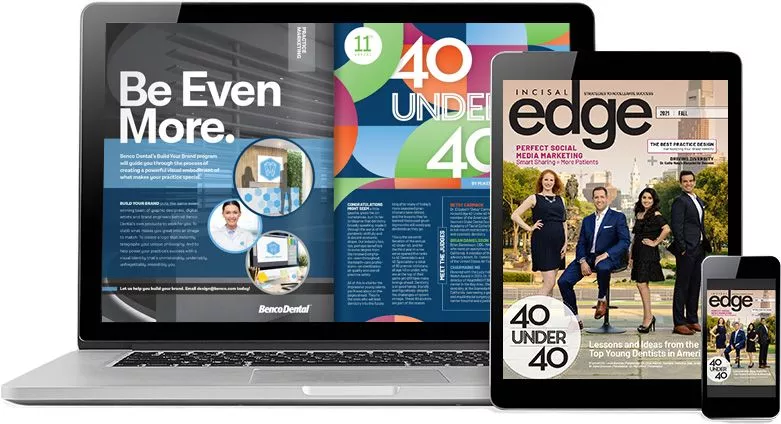The
(Exciting, Scary, Brave, Smart, Efficient, Awe-Inspiring, Time-Saving, Career-Extending)
New World of Dental A.I.
BY JERRY MARKON AND EDWARD KOBESKY
What can it do today? What will it do tomorrow? How fast is it catching on? How do users feel? And should dentists worry that it might someday replace them? We talked to doctors, futurists, industry leaders, influencers, attorneys, technologists and entrepreneurs to bring you a comprehensive update on the current state of artificial intelligence in dentistry.
EAGER TO LEARN how artificial intelligence could aid the practice of dentistry, Dr. Joseph Search sat down in his bedroom one afternoon in April 2021, logged on with his colleagues and watched an online demonstration of the technology often hailed as the industry’s future.
The blurry, black-and-white dental X-rays that AI had transformed into clear, colorful images were certainly enticing. But the dentists viewing the demo, put on by the Verber Dental Group in central Pennsylvania, had some hesitations.
“Everyone was excited about the capabilities the technology was offering,” recalls Dr. Search, 40, a Verber group partner. “But they were wondering, ‘Hey, is this going to replace my diagnosis?’ ”
Enthusiasm picked up as the Verber Group soon began implementing the dental AI platform they had previewed, built by Boston-based Overjet—so much so that by the time Dr. Search opened a new Verber Group location in Mechanicsburg, Pennsylvania, in June 2022, he was all in with AI.
Today, Overjet is integrated throughout his new office, Search Dental, with staff each morning viewing an AI-powered profile of every patient on a homepage-like screen. The system displays who is due for X-rays, crowns or other work, analysis that is used to prepare dentists and hygienists for the day.
Dentists then use screens dotting every room to show patients their X-rays in the Overjet system, which has analyzed each image and overlaid it with the color-coded markings that highlight problems such as tooth decay or bone loss.
“Patients can easily visualize what we are telling them. They can see the decay much easier because it’s highlighted,” says Dr. Search, who is so sold on AI’s promise that he sees it as “transformative for the industry. It improves patient care and allows doctors to better diagnose disease.”
A.I. will transform the industry.
—Dr. Joseph Search Verber Group Partner
Dr. Search’s experience illustrates that it is now beyond debate whether AI is coming to dentistry. It’s already here—and is progressing beyond radiograph readings and crown restorations into a brave new future that experts say offers boundless opportunities for patient care.
Though precise numbers remain unclear, AI adoption in dental practices is growing rapidly, according to interviews with dentists and companies that produce AI software and other applications, as well as an Incisal Edge review of the latest academic literature.
A 2023 survey of U.S. dentists and patients by the website Dentaly found that 35 percent of dentists have implemented AI, with practitioners citing benefits including faster and more efficient workflows and improved diagnostic accuracy.
A broader 2024 Inside Dentistry magazine survey—which included dental professionals in practice management, purchasing and technology adoption in addition to those involved in clinical care—reported that 18 percent of respondents have already integrated AI into their workflows. An additional 47 percent said they may be open to using AI products.
Currently, dental AI is primarily used for imaging, diagnostics and intraoral scanners, along with designing crowns and other restorations. It plays other roles as well, such as automating some back-office functions in practices and helping fix crooked teeth.
There’s even a toothbrush on the market with AI-powered voice guidance offering advice on how to brush. Such devices could wind up brushing smiles that were themselves generated by AI; some companies now offer what is known as AI-driven smile designing to improve your grin.
Going forward, AI is widely expected to advance in innovative areas such as robotic devices that aid dental procedures, virtual and augmented reality to help educate dental students, enhanced teledentistry to treat patients remotely and predictive analytics to enable proactive care.
It will also make people healthier, according to a 2024 study by a team of dental researchers from Romania, Belgium and Sweden, which found that integrating AI into dentistry will ease oral disease and “holds promise . . . in the detection of dental pathologies and pre-radiotherapy screening for head and neck cancer patients.”
Oral-B iO Series 9 delivers a uniquely personalized clean with an interactive display and seven smart modes.
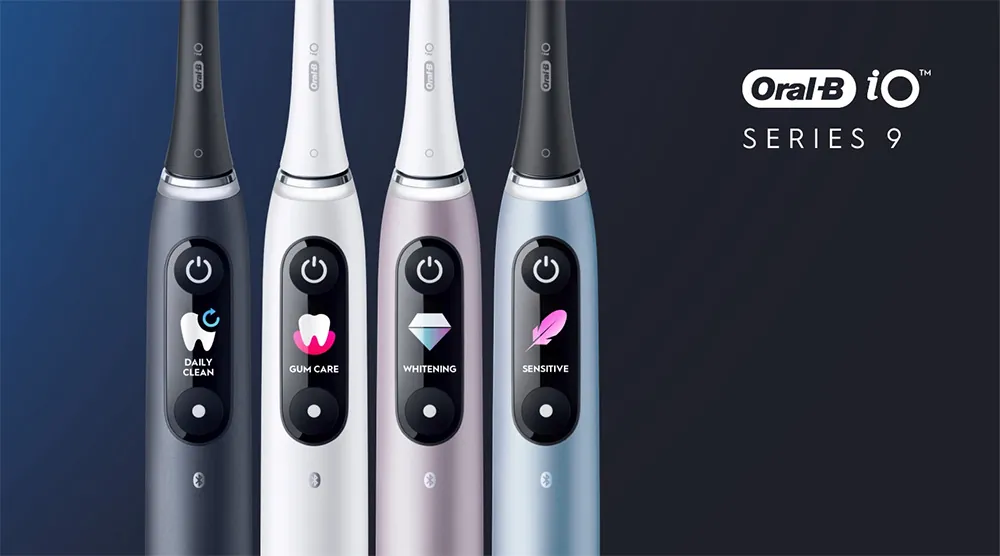
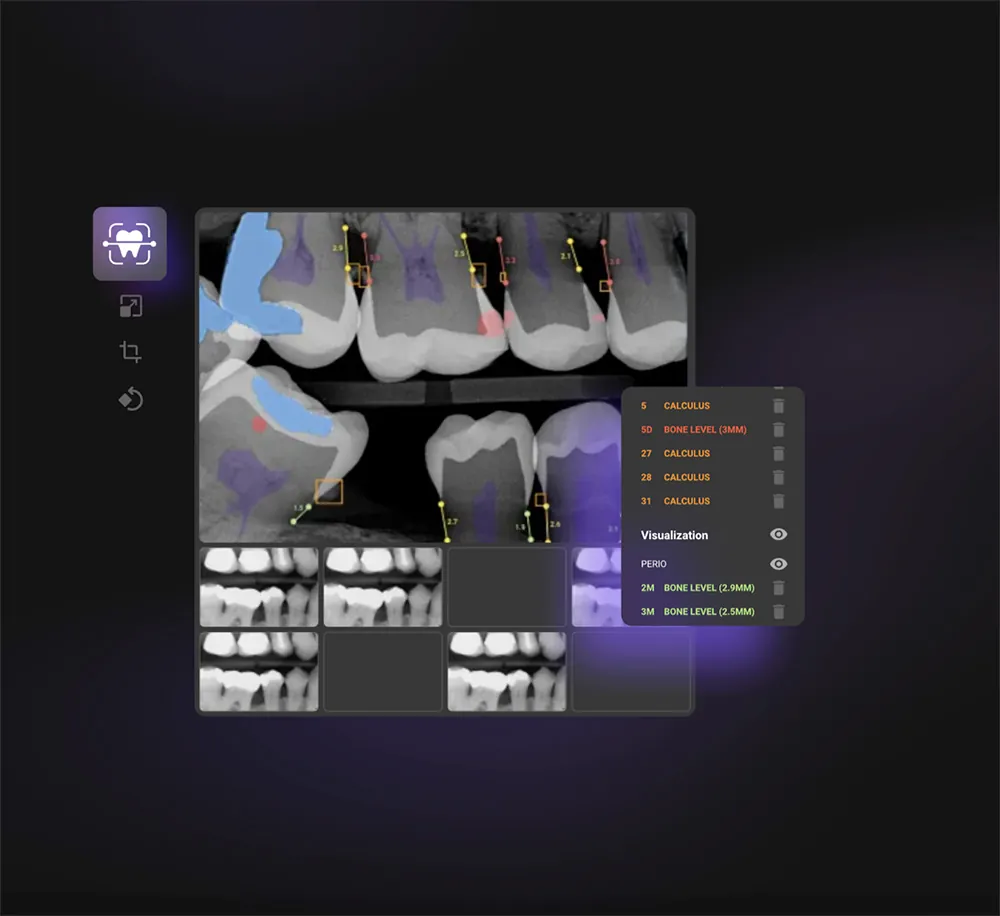
Overjet AI detects oral diseases with precision, ensuring dentists can offer the best care.
Dr. Robert Margeas, Inside Dentistry’s editor in chief, says that over the past several years, “AI has really picked up in dentistry,” though he estimates that “no more than a third of dentists are using AI right now.”
“You have the early adopters, and then you have the people who are waiting to see where it goes,” says Dr. Margeas, 63, who owns Iowa Dental Group in Des Moines, Iowa. “Some people always want to be on the cutting edge, and others are waiting for their colleagues to give them a reason why AI is much faster, more efficient and more profitable.”
Another industry veteran, Dr. Gordon J. Christensen, says many dentists still harbor skepticism about AI due to concerns about its cost and reliability—and out of a general resistance to change. “Dentists are skeptical of anything new,” says Dr. Christensen, 88, CEO of Practical Clinical Courses, cofounder of the Clinicians Report Foundation and a regular on this magazine’s annual 32 Most Influential People in Dentistry list.
He adds that he believes AI holds “significant potential” to soon help practices in areas such as robotic-assisted surgery, education of dentists and back-office functions such as management and billing. “AI is like the automobile in 1918,” he says. “It’s here, it works, but we have other things to compete with it. You still had a good horse.”
A.I. is like the automobile in 1918. It’s here, it works, but we have other things to compete with it. You still had a good horse.”
How A.I. Works
By Jeffrey Allan
AI, AT ITS SIMPLEST, refers to computer systems designed to perform tasks that typically require human intelligence, such as recognizing patterns or making predictions. Unlike traditional software, which follows static instructions, AI learns and adapts by processing new information. In dentistry, for example, this could mean using AI to help analyze digital X-rays, treatment records and clinical data.
This allows you to more accurately identify early signs of cavities, gum disease and other conditions that might go unnoticed during a routine examination.
The true power of AI lies in its ability to process large amounts of high-quality data. By examining thousands of X-rays from dental practices, AI systems can detect subtle clues that may signal developing problems. This can enable you to make a more accurate diagnosis and provide earlier, more effective treatment options. However, these breakthroughs depend on ethical data sharing and responsible use. When dentists share data, they help improve AI tools, and that benefits the entire profession. This will help ensure that these systems remain trustworthy and able to make a positive impact on patient care.
By integrating AI thoughtfully, you can enhance diagnostic accuracy and treatment outcomes while helping improve the profession. But the technology also comes with certain responsibilities. AI certainly sometimes feels like a runaway train. While you may not be able to steer the progress of AI as a lone individual, you can choose which software or robotics products you will use, how you will use them and whether
you allow them to merely augment or partially supplant your own expertise. If all your colleagues do the same, dentistry becomes a powerful collective force—one that will have a meaningful impact on how the future unfolds.
 JEFFREY ALLAN is director of the Institute for Responsible Technology at Nazareth University in Rochester, New York.
JEFFREY ALLAN is director of the Institute for Responsible Technology at Nazareth University in Rochester, New York.
His two decades of experience span Fortune 500 companies and Silicon Valley startups. He is also a psychologist and coauthor of “Writing AI Prompts for Dummies.”
A.I. and Transformation
By Dr. Bertalan Meskó
A PARADIGM SHIFT has been taking place in health care since the beginning of the twenty-first century. Digital health technologies have started to break down the ivory tower of medicine and make patients the point of care. A crucial element of this is patients becoming members of their medical teams.
Specialties such as cardiology, oncology, dermatology, primary
care and radiology stand out. As it’s hard to imagine the point of care significantly changing for dentistry, this specialty often gets neglected—which is a mistake.
AI is transforming diagnosis, decision making and treatment planning for dentists, and it promises better outcomes for patients. Even with X-rays, dentists sometimes miss small cavities. AI can cost-effectively detect early-stage dental caries and vertical root fractures more accurately. Periodontitis can also be hard to spot in its early stages, but it’s a major cause of tooth loss. AI helps dentists catch it early. Or consider creating the ideal orthodontic treatment plan, which is time-consuming and requires lots of measurements and analysis. AI models help orthodontists create the best treatment plans and predict what the result will look like.
Augmented reality (AR) is also leaving its mark on reconstructive and aesthetic procedures to help patients know what they will look like after treatment. SmartTek developed an AR app that uses a phone or tablet’s camera to overlay virtual depictions of the improved set of teeth prior to the procedure. This allows patients and dentists to configure features of their teeth such as height and spacing to their liking before they even enter surgery.
Teledentistry is transforming access to oral health care by bridging gaps in availability and affordability. This approach enables patients to receive care more conveniently, often at a lower cost. Moreover, teledentistry connects patients with professionals who might otherwise be out of reach.
What truly matters is that dentists acknowledge the importance of the digital health transformation and their patients’ need to engage with their care wherever they physically are.
The rule of thumb: AI will not replace medical professionals, but those who know how to use AI efficiently will
eventually replace those who do not.
 DR. BERTALAN MESKÓ, Ph.D., is director of the Medical Futurist Institute and a private professor at Semmelweis Medical School in Budapest, Hungary. He specializes in analyzing the impact of science-fiction technologies on global medicine and health care and has delivered more than 900 keynote addresses at Harvard, Stanford and Yale, among other schools, as well as organizations such as the WHO. Visit medicalfuturist.com.
DR. BERTALAN MESKÓ, Ph.D., is director of the Medical Futurist Institute and a private professor at Semmelweis Medical School in Budapest, Hungary. He specializes in analyzing the impact of science-fiction technologies on global medicine and health care and has delivered more than 900 keynote addresses at Harvard, Stanford and Yale, among other schools, as well as organizations such as the WHO. Visit medicalfuturist.com.
Any hesitation will fade over the next two years, with AI becoming “the standard of care in dentistry to support diagnosis and treatment planning,” says Florian Hillen, 32, founder and CEO of VideaHealth, based in Boston.
“We know it’s the fastest-adopting technology in the last couple of decades. It will penetrate very quickly,” says Hillen, whose company’s AI-powered platform is used in more than 40,000 dental offices, where it helps doctors analyze X-rays and makes diagnostic recommendations.
Already, a series of recent academic studies have documented benefits from dental AI that include its high level of accuracy in rapidly analyzing vast amounts of data—including X-rays, images and patient records—and detecting problems such as bone loss and gum disease.
Yet while the transition to a potential AI future has been steady,
it has also been uneven, with some dentists reluctant to acquire potentially costly AI systems—or just too busy juggling their daily workload.
 Dr. Nikita McDaniel, who owns McDaniel Family Dental outside Kansas City, Missouri, has found dental AI software very helpful in analyzing X-rays and communicating findings to patients. “It’s like having a second set of eyes,” she says.
Dr. Nikita McDaniel, who owns McDaniel Family Dental outside Kansas City, Missouri, has found dental AI software very helpful in analyzing X-rays and communicating findings to patients. “It’s like having a second set of eyes,” she says.
She is potentially interested in investing further in AI by using it to help file insurance claims. Just not yet. “I haven’t had time—it’s been really busy,” says Dr. McDaniel, 33, adding that none of her friends in the industry are using AI or even talking about it.
Yet many say that over time, AI could revolutionize the profession. AI “is transforming [dentistry] by making treatments faster and more precise,” says Robert Befidi, president of diagnostics at Brea, California–based Envista, which owns DEXIS, a dental imaging and digital solutions firm. “We believe that AI will be a key component for all aspects of the digital dentistry workflow.”
AS AI TECHNOLOGY advances, that potential will partly mean refining existing AI uses such as improving algorithms for the analysis of dental images, currently the subject of ongoing research.
“I think AI will grow and evolve in realms it has already infiltrated: X-rays and diagnostics. It will still make a lot of strides there,” says Dr. Kashfia Vohra, 35, co-owner of Kind Dental in Scotch Plains, New Jersey, who has integrated several AI systems into her practice.
Yet AI is also expected to stride into the future, courtesy of innovators like Nate Anderson. A former senior executive at Uber and Uber Eats, Anderson is applying AI systems he learned at those companies to try to solve one of dentistry’s most pressing problems: the national hygienist shortage, which we’ve covered in these pages.
In 2021, Anderson cofounded Teero, a Minneapolis-based dental staffing company that operates an app that matches hygienists seeking temporary work with dental offices that post open shifts. The company uses AI to develop the underlying technology and personalize the app for each hygienist, similar to the way Uber Eats personalizes restaurant choices for users.
“The AI has greatly expedited how quickly we can build” the system and helps keep costs down for users, says Anderson, 35, whose service has spread through the Midwest and Northeast and aims to go national next year.
“AI makes it a very magical experience.”
In Miami, a company called Neocis is trying to break through in another area of growing interest to dental AI aficionados: robotics. Founded in 2009, the firm developed a robotic system for dental surgery, known as Yomi, that it says is now used in several hundred dental offices nationwide.
We believe thatA.I.will be a key component for all aspects of the digital dentistry workflow.’
—Robert Befidi
President of Diagnostics, Envista
Integrating A.I. with robotic systems is poised to revolutionize dental procedures.”
—Alon Mozes CEO, Neocis
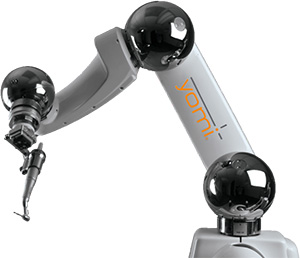 Yomi assists dentists with implant surgeries, helping plan procedures using software that incorporates AI algorithms. The robotic arm then holds the drill along with the dentist, helping guide him or her to the correct position, angle and depth.
Yomi assists dentists with implant surgeries, helping plan procedures using software that incorporates AI algorithms. The robotic arm then holds the drill along with the dentist, helping guide him or her to the correct position, angle and depth.
“Most dentists making an incision are just crossing their fingers and hoping they don’t they hit a nerve and can get the implant in the right spot,” says Neocis CEO and cofounder Alon Mozes, 47. “This robot helps them do exactly what they planned.”
Robotics in dentistry are now mostly used for implant surgery, dentists and other experts say, but Mozes says they will eventually affect “pretty much everything in a dental office.” A 2023 study by two dental researchers in India, published by the National Institutes of Health’s National Library of Medicine, concurred.
“Integrating AI with robotic systems is poised to revolutionize dental procedures,” the report said. “AI-driven robotic dentistry can enhance precision and automation in tooth drilling, implant placement and orthodontic adjustments.”
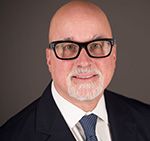 Some in dentistry offer mixed views of the Yomi system, citing in part its relatively high cost. Dr. Margeas, the Inside Dentistry editor in chief, says the system can run more than $200,000, which would be prohibitive for many practices. “Yomi is very, very expensive, but it’s a very, very cool product, and I know people who use it and are very happy with it,” he says, adding that increased use of robotics in dentistry overall “is not really sci-fi. It’s coming.”
Some in dentistry offer mixed views of the Yomi system, citing in part its relatively high cost. Dr. Margeas, the Inside Dentistry editor in chief, says the system can run more than $200,000, which would be prohibitive for many practices. “Yomi is very, very expensive, but it’s a very, very cool product, and I know people who use it and are very happy with it,” he says, adding that increased use of robotics in dentistry overall “is not really sci-fi. It’s coming.”
(Mozes declined to comment on pricing, but said that Neocis “can make [Yomi] affordable for any practice that places dental implants.”)
A.I.’s Open Questions
By Jeff Tonner
THE EXTRAORDINARY changes brought about by AI raise a significant legal question: Can a dentist rely upon AI for primary diagnoses and treatment planning? As you might imagine, courts have not provided much clarity in this emerging field. In its stead, and as a dental-malpractice defense attorney with gray hair, please permit me to share some defensive tactics.
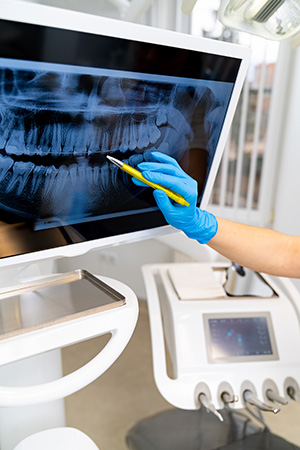 As our hypothetical model, let’s say you’re using an FDA-approved system that uses artificial intelligence to read X-rays and detect defects not visible to the naked eye. I believe a practitioner must always review the film in conjunction and suggest a didactic progress-note entry that encompasses both analytics: “AI identifies caries #13M. I [agree] [do not detect the same]. Pt fully informed of both and [agrees to tx] [instructs me to watch only].” This recordkeeping 1) informs the reader of the agreement/disagreement between AI and the dentist, 2) acknowledges that the patient understands who/what diagnosed the caries and 3) allows the patient to accept/reject AI either with or without the practitioner’s concurrence. Consent forms also should be modified: “This office supplements some diagnoses and treatment planning with artificial-intelligence tools. You will be notified where this occurs.”
As our hypothetical model, let’s say you’re using an FDA-approved system that uses artificial intelligence to read X-rays and detect defects not visible to the naked eye. I believe a practitioner must always review the film in conjunction and suggest a didactic progress-note entry that encompasses both analytics: “AI identifies caries #13M. I [agree] [do not detect the same]. Pt fully informed of both and [agrees to tx] [instructs me to watch only].” This recordkeeping 1) informs the reader of the agreement/disagreement between AI and the dentist, 2) acknowledges that the patient understands who/what diagnosed the caries and 3) allows the patient to accept/reject AI either with or without the practitioner’s concurrence. Consent forms also should be modified: “This office supplements some diagnoses and treatment planning with artificial-intelligence tools. You will be notified where this occurs.”
AI presents an exciting frontier for dentists and nearly all other fields. Until our courts provide better guidance, giving patients a voice in whether it should apply to their treatment seems a proactive and safe approach.
 JEFF TONNER, the author of “Malpractice: What They Don’t Teach You in Dental School,” devotes his law practice to advocating for dentists. His latest venture, Lightning Dental Charts (lightningdental.co), is a software suite for creating progress and consent notes that are highly legally compliant.
JEFF TONNER, the author of “Malpractice: What They Don’t Teach You in Dental School,” devotes his law practice to advocating for dentists. His latest venture, Lightning Dental Charts (lightningdental.co), is a software suite for creating progress and consent notes that are highly legally compliant.
A.I.’s Unique Urgency
By Tim Brunelle
REMEMBER WHEN the internet arrived and dental marketing changed forever? Today it’s almost impossible to run a practice without online scheduling, patient portals and digital records. But remember—you had time to learn those tools, terms and habits. The urgency of AI feels real because it is. Today you have free access to at least four frontier large language models (LLMs): ChatGPT, Google’s Gemini, Meta’s Llama and Anthropic’s Claude. Here’s how to develop an AI mindset to help your practice thrive.
• First, AI is different from the software you know. If you’ve tried using an LLM like a search engine, you probably didn’t see much benefit. Instead, try working with Claude or ChatGPT as if they were your treatment coordinator’s assistant.
Prompt: “Let’s discuss how to get more patients to schedule cleanings twice a year. What do you need to know from me to begin?”
• Second, ask AI how you can use it more effectively. For the first time in history you have a tool that can teach you how to use it while you use it.
Prompt: “I want to improve our practice’s marketing. Where should we start, and what information do you need from me?”
Ask it to analyze your hygiene appointment reminders and suggest 10 ways to make them more engaging. You’ll be surprised at how it thinks about patient psychology.
• Third, ask your AI tough questions. It can transform spreadsheets into dashboards and images into words. Its greatest advantage is helping you work in ways you couldn’t imagine before.
Prompt: “I’ve attached our practice management reports from last year. What patterns do you see in patient retention that we might have missed?”
The truth is, AI is weird. But so was digital X-ray technology when it first arrived. Your mindset doesn’t need to be perfect—it just needs to be open to the possibilities.
 TIM BRUNELLE teaches AI for Entrepreneurs at the Minneapolis College of Art and Design, consults with Fortune 500 firms and writes about creativity, marketing and AI at timbrunelle.substack.com.
TIM BRUNELLE teaches AI for Entrepreneurs at the Minneapolis College of Art and Design, consults with Fortune 500 firms and writes about creativity, marketing and AI at timbrunelle.substack.com.
Many in the industry say Yomi and other robotics systems—such as an AI-powered one being developed by a Boston company called Perceptive (see “He, Robot,” page 38) to help with crowns and other restorative procedures—symbolize where dentistry is headed.
“The future is robotics, for sure. It will change everything,” says Dr. Matthew Doan, 38, managing clinical director at DECA Dental in Dallas and a member of Incisal Edge’s 40 Under 40 in 2022. “Would you rather have a perfect filling or crown done by a robot or a human being? Everything is subjective on the human side. You could be having a bad day, and your hand slips by accident and you nick the patient’s tongue. With robots you can minimize that risk.”
SOME IN DENTISTRY also see virtual reality—immersion into computer-generated simulations—and augmented reality, which superimposes computer-generated images onto reality, as a key part of the future.

A number of recent studies have said the twin technologies pack the potential to transform dental education and training by providing immersive experiences that simulate clinical scenarios. Students interact with three-dimensional models of teeth and supporting structures and perform “everything from routine cleanings to more complex procedures such as root canal therapy and crown preparation,” according to a 2024 study by researchers in Taiwan published in the Journal of Dental Sciences.
 AI’s role, the study said, can be to “reduce the workload for educators by automatically adjusting task difficulty in real time and offering instant feedback, making training sessions more efficient.”
AI’s role, the study said, can be to “reduce the workload for educators by automatically adjusting task difficulty in real time and offering instant feedback, making training sessions more efficient.”
Augmented reality combined with AI in particular “can have a huge impact,” says Hillen, the VideaHealth CEO. “It helps with all the mechanical skills—how to do extractions, implants and root canals.” His company is working with dental and hygienist schools to train students to read radiographs and develop treatment plans with a special training software that uses AI.
“The AI gives them feedback,” says Hillen, who believes a majority of graduates will at some point “be trained on AI.”
AI is also expected to continue enhancing another growing aspect of the profession: the expanded use of teledentistry since the pandemic to treat patients remotely via videoconference. No less an authority than the American Dental Association endorsed AI’s role in remote treatment in a 2022 white paper on artificial and augmented intelligence in dentistry.
Back at the dental office, AI is poised to exert major influence on a vital yet often unheralded set of functions: back-office operations such as appointment scheduling, billing and patient data handling.
“While AI’s role in clinical applications such as diagnostics and treatment planning is widely recognized, its impact on the operational side of dentistry is equally transformative but less discussed,” according to a June 2024 article by the California Dental Association.
Some practices are already using AI applications such as chatbots to answer patient questions and software to track patient
phone calls. The central Pennsylvania–based Verber Dental Group, for example, uses a platform called Weave AI to transcribe all calls, track patient appointment requests that have been missed—and even detect what the company calls the “sentiment” of patients and staff members.
“It’s a little bit freaky how well it can judge whether the call was a positive interaction or negative. It can judge the tone of voice and the language,” says Dr. Michael Verber, 49, the group’s chairman and CEO. “We know which offices have higher and lower customer satisfaction. That allows us to train and improve and coach our people.”
As dentistry continues to consolidate, with more graduates working for larger groups or corporations, AI’s influence on “the administrative process areas of dentistry will grow rapidly,” Dr. Verber adds.
The technology’s potential impact on another vital area of dentistry—predicting future oral health conditions based on rapidly processing masses of data, or predictive analytics—is also widely seen as profound.
I can read and analyze probably one patient history in three to four hours. A.I. can do it in one second.”
Dr. Jay Patel, an assistant professor and director of the Center for Dental Informatics and Artificial Intelligence at Temple University, is trying to make that promise a reality. He trained an AI model that he says can analyze patient data—including medical histories and “social determinants of health” such as economic status and living conditions—to predict the progression of oral disease. Patients can then be treated preventively.
He calls it precision dentistry. “I can read and analyze probably one patient history in three to four hours. AI can do it within one second,” says Dr. Patel, 34. Putting such predictive analytics in wide use, he adds, “will save health care costs and increase quality of life. It will be transformative.”
EVEN AS THE AI future beckons, the AI present is rapidly becoming a practice fixture.
“There has been a big shift in how dentists think and talk about AI,” says Osku Sundqvist, director of software business development in the digital imaging and applications division of Planmeca, a Finnish AI dental software platform with many American customers.
As recently as 2019, when Planmeca put on AI exhibitions at dental trade shows, “nobody was interested,” he says. But by 2023, “AI was everywhere.” Sundqvist credits in part the public craze over generative AI occasioned by ChatGPT’s debut in late 2022. “People are seeing that this technology has become mature.”
Not just at practices, either: Lisa Fleming, digital dentistry manager at Benco Dental, says nearly every manufacturer is embedding AI into its user interface, and “we think the number will increase significantly in the next five years.”
Ditto for dental laboratories. “We use AI across our entire dental lab for every product we make,” says Stephenie Goddard, 55, CEO of Newport Beach, California’s Glidewell Dental, the largest U.S.-based dental lab.
Glidewell makes and supplies dentists with everything from crowns to bridges and future beckons, the AI present is rapidly becoming a practice fixture.
“There has been a big shift in how dentists think and talk about AI,” says Osku Sundqvist, director of software business development in the digital imaging and applications division of Planmeca, a Finnish AI dental software platform with many American customers.
As recently as 2019, when Planmeca put on AI exhibitions at dental trade shows, “nobody was interested,” he says. But by 2023, “AI was everywhere.” Sundqvist credits in part the public craze over generative AI occasioned by ChatGPT’s debut in late 2022. “People are seeing that this technology has become mature.”
Not just at practices, either: Lisa Fleming, digital dentistry manager at Benco Dental, says nearly every manufacturer is embedding AI into its user interface, and “we think the number will increase significantly in the next five years.”
Ditto for dental laboratories. “We use AI across our entire dental lab for every product we make,” says Stephenie Goddard, 55, CEO of Newport Beach, California’s Glidewell Dental, the largest U.S.-based dental lab.
Glidewell makes and supplies dentists with everything from crowns to bridges and
implants, and Goddard—a fixture on our annual 32 Most Influential list—says integrating AI has boosted quality, reduced remakes and exponentially increased speed. Crowns, for example, traditionally
had a two-week turnaround time. Now, “we try to turn around most of our products in three days maximum,” Goddard says. “In some instances, when we get a scan from a dentist, we can send out that crown that same night.”
There has been a big shift in how dentists think and talk about A.I. People are seeing that this technology has become mature.”
Among the leaders in dental AI is Overjet, the Boston firm whose AI-powered radiograph analysis platform uses a process called segmentation to add color-coded indicators to traditionally black-and-white dental X-rays to help clinicians isolate concerns and communicate them to patients. The platform also analyzes patient records to identify treatment needs and quantifies bone level measurements to help diagnose gum disease.
“Our foundation is analysis of X-rays, but we are doing more to give dental practices information they did not have,” says Overjet communications director Logan Goldberg, 29, noting that the platform is used by more than 30,000 clinicians.
Another key dental AI player is West Hollywood, California–based Pearl, whose “Second Opinion” AI platform offers a suite of solutions, including analysis of dental X-rays to detect oral health problems.
Dr. Vohra, the New Jersey dentist, grew intrigued with the Pearl platform when she saw it demonstrated at a continuing education seminar in San Antonio in April 2024. She began using it immediately, finding that the color-coded anatomical images of teeth make it much easier to communicate with patients.
But she went further, investing this summer in a 3D printer and crown mill to make crowns in-house. “We take a 3D scan using an intraoral scanner, send it directly to the crown mill and AI helps us recognize the anatomy of the crown and the tooth,” she says. “It’s pretty spot-on.”
A.I. and VCs
 Doug Brown is cofounder and managing partner of the Dental Innovation Alliance (DIA), a VC firm focused on accelerating dental innovation; he was No. 4 on our 2024 list of the 32 Most Influential People in Dentistry. Kentucky Morrow (right) is his colleague and principal of DIA.
Doug Brown is cofounder and managing partner of the Dental Innovation Alliance (DIA), a VC firm focused on accelerating dental innovation; he was No. 4 on our 2024 list of the 32 Most Influential People in Dentistry. Kentucky Morrow (right) is his colleague and principal of DIA.
Why dentists should invest in dental companies
Dentistry is in a golden age of innovation, with well over a thousand entrepreneurs developing concepts and products. By focusing on the most promising categories, dentists can make informed investment decisions that benefit both their portfolios and dentistry’s future.
How professional experience can cloud investment judgments
Just as any investor should seek diversification, dental investors should consider their clinical experience both an asset and a potential liability. You may overestimate the market potential of technologies you personally find helpful or underestimate the challenges of bringing a product to market. There is also a risk of bias toward familiar technologies, causing you to overlook innovative solutions that diverge from traditional
practices. Finally, in making “one-off” decisions, you may not have the financial and due diligence expertise to vet companies seeking your investment to ensure a sufficient return.
Getting the timing right
Dental professionals should consider investing in this wave of innovation now, since well-managed, diversified venture investment approaches have historically outperformed most other strategies. The global dental services market is expected to grow significantly. Large group practices, including DSOs, are deploying business analysts and technologists to collaborate with clinical professionals, offering a powerful approach to testing concepts, reaching good decisions and deploying great ideas more quickly.
Where the action is
Several sectors are currently showing unique promise. AI is being adopted for clinical and diagnostic support, automated front desk tasks and revenue cycle management. It promises to improve the consistency of clinical care, to drive practice profitability through reduced costs, streamlined care, higher treatment acceptance and a better patient experience. Similarly, advances in 3D printing and imaging systems are unlocking the promise of digital dentistry. Additionally, digital software that improves office-level systems that can reduce staff turnover and labor costs is beginning to transform practice management.
Dental professionals should consider investing in this wave of innovation now, since well-managed, diversified venture investment approaches have historically outperformed most other investment strategies.”
How dentists can play a key role as both investors and advisors
By applying their expertise to investment decisions, and by thoughtfully testing and deploying modern technology, dentists can contribute to the advance of the industry. Likewise, professional investors can rely on the judgment of forward-thinking dentists to
increase their returns.
Mitigating risk, and what VCs bring to the table
Investing through a VC group with experts in dentistry, technology and financial investment can supplement your clinical expertise by providing a thorough approach to evaluating a business’s technical and growth potential. VCs typically invest in a portfolio of startups, spreading risk across multiple ventures. This diversification can simply help protect your investment. VC firms also often have access to investment opportunities or deal terms that are not available to individual investors, enabling dentists and dental professionals to participate in promising ventures at an early stage, and with much higher upside. Many VC firms also provide post-investment support to their portfolio companies, offering strategic guidance and industry connections to help startups succeed. This support can significantly increase a startup’s chances of success, potentially leading to better investor returns.
There has been a big shift in how dentists think and talk about A.I. People are seeing that this technology has become mature.”
—Osku Sundqvist Director of Software Business Development, Planmeca
A.I. at Scale
How are big practices implementing AI systemwide? And what’s the outlook from a big-business perspective? We asked Dr. Theresa Wang, DDS, lead prosthodontist and chief clinical and development officer at ClearChoice, for her thoughts.
(The conversation has been edited for length and clarity.)
How are you currently using AI for clinical purposes at ClearChoice?
Currently, we use AI primarily to create efficiencies in labor-intensive or time-consuming tasks. AI helps provide blueprints for general tooth placement, which can help expedite smile design. It also assists in “nesting” teeth before they are printed, configuring them for optimal results while still allowing manual adjustments. These applications reduce the time involved in designing and manufacturing fixable arch teeth.
In the short term, we plan to continue leveraging AI to make labor-intensive tasks more efficient, improving the ability to help more patients while enhancing work experiences for our teams. In the long term, we aim to expand AI applications to expedite processes and improve treatment planning while maintaining human oversight for critical decision making to ensure the best outcomes.
Is the adoption of technology uniform across all ClearChoice locations?
Technology adoption is a blend of systemwide access and individual discretion. While we have centers that evaluate new technologies’ impact on patient outcomes, provider experience and process efficiency, once a technology is vetted and meets these criteria, it’s made accessible across the network. That said, practices have the autonomy to decide how they incorporate these tools. ClearChoice does not mandate how doctors treat patients or the technologies they use; we focus on innovation to benefit the network and the patient experience.
In general, what is your opinion of AI-enabled robotics in dentistry?
They can help enhance precision and efficiency, especially in straightforward cases. While robotics can assist with tasks like implant placement or crown preparation, dentistry often involves complexities that require clinician expertise and adaptability that may limit the robot’s capabilities, especially in more nuanced cases. Cost is another important consideration. Current technologies like surgical guides, which are relatively low-cost and attainable through planning software and in-office 3D printing, already provide effective solutions for many procedures.
For now, robotics’ adoption is likely to grow gradually as they demonstrate clear benefits in patient outcomes and workflow efficiencies. But it’s important to ensure that these technologies integrate seamlessly with the personalized care that is central to dentistry.
How do patients regard AI and robotics right now?
We don’t often have patients specifically asking about AI or robotics. Still, it’s essential for patients to understand that these tools are not intended to replace clinician expertise.
For procedures like dental implants, which require high precision, proper communication with the patient is key when incorporating advanced technology. Patients should feel reassured that clinician oversight is always integral to the process and that technology serves as a supportive tool rather than a substitute for the skill and capabilities of their care provider.
Some younger practitioners are understandably concerned that AI and robotics could affect their future. What is your advice to them?
This is an exciting time to enter the field. I would encourage students and new dentists to embrace these advances. Choose dental schools that offer exposure to cutting-edge technologies like 3D printing, AI and robotics, as this will not only prepare you for the future but also show how technology enhances the profession. And for those considering postgraduation plans, DSOs offer a great opportunity for young clinicians to open a practice and work directly with the network’s latest technology—and with minimal focus on operations. All in all, AI and robotics are here to stay, and practitioners who are trained and comfortable with them will be better positioned to thrive in an evolving field.
Crowns are also a focus at 3Shape, a company in Denmark that began investing in AI in 2014, hired its first AI developers the same year and since 2021 has used generative AI to automate crown design. Dentists upload intraoral scans to the cloud for 3Shape, which uses them to automatically design the crown.
The company then sends back the AI-designed restoration in what it says is as little as 90 seconds. Rune Fisker, senior vice president for product strategy at 3Shape, says in an interview that the firm designs about 150,000 crowns a month, with one-third of its customers in the United States.

AI, Fisker adds in a recent LinkedIn post, is “poised to revolutionize how [dentists] care for people. We should be embracing its transformative potential.”
Align Technology, which manufactures Invisalign, is doing so at every turn, integrating AI into many products and technologies. They include automatic segmentation of teeth to predict tooth shapes, and a clinical simulation of the patient’s smile after treatment.
“We’re developing AI models to determine aligner fit and detect attachments, and we’re uniquely positioned to use AI models to enable our doctors to maintain continuity of care,” says Sreelakshmi Kolli, Align’s executive vice president and chief product and digital officer. Seemingly speaking for an entire intrigued industry, she adds: “We are very excited about the possibilities.”



